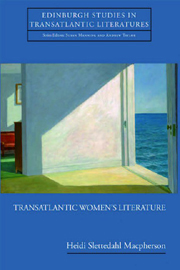Book contents
- Frontmatter
- Contents
- Acknowledgements
- Introduction: ‘No Region for Tourists and Women’
- Part 1: The Exoticised Other
- Part 2: Memoirs and Transatlantic Travel
- Part 3: Negotiating the Foreign/Re-Inventing Home
- Introduction
- 5 ‘An Invention of the Americans’: Negotiating the Foreign in Anne Tyler's Novels
- 6 Cross-Dressing and Transnational Space: Isabel Allende's Daughter of Fortune
- Conclusion
- Bibliography
- Index
6 - Cross-Dressing and Transnational Space: Isabel Allende's Daughter of Fortune
from Part 3: Negotiating the Foreign/Re-Inventing Home
Published online by Cambridge University Press: 12 September 2012
- Frontmatter
- Contents
- Acknowledgements
- Introduction: ‘No Region for Tourists and Women’
- Part 1: The Exoticised Other
- Part 2: Memoirs and Transatlantic Travel
- Part 3: Negotiating the Foreign/Re-Inventing Home
- Introduction
- 5 ‘An Invention of the Americans’: Negotiating the Foreign in Anne Tyler's Novels
- 6 Cross-Dressing and Transnational Space: Isabel Allende's Daughter of Fortune
- Conclusion
- Bibliography
- Index
Summary
Isabel Allende's novel Daughter of Fortune (1999) engages with a range of journeys across and between continents, leading at least one critic to argue that the novel relates more closely to the emerging field of Inter-American Studies than any other interdisciplinary field; in this argument, the text's focus on the journeys from South to North America take precedence over both the transatlantic and the transpacific journeys that individual characters undertake (or are forced to undergo). As if to back up this point, the Flamingo paper-back version of the novel comes complete with a map showing the routes taken by commercial ships, but only those which circumnavigate the Americas. The map focuses on the ‘cartography of the characters' travels’, but only those that acknowledge ties to the Americas; the transpacific and transatlantic routes are invisible in this rendering.
Whilst I accept that the principal hemispheric journey, and the peripatetic nature of the main heroine within North America both suggest that this arena is the locus of the text, the reality is that the novel is as much defined by the initial transatlantic movements and later transpacific ones as it is by inter-American ones, and that all of these journeys collectively have lasting repercussions for identity shifts. Thus the novel breaks out of the boundaries of a transatlantic narrative to encompass other narratives of movement. This may therefore make it seem an odd text on which to conclude a study of transatlantic literature.
- Type
- Chapter
- Information
- Transatlantic Women's Literature , pp. 155 - 173Publisher: Edinburgh University PressPrint publication year: 2008



